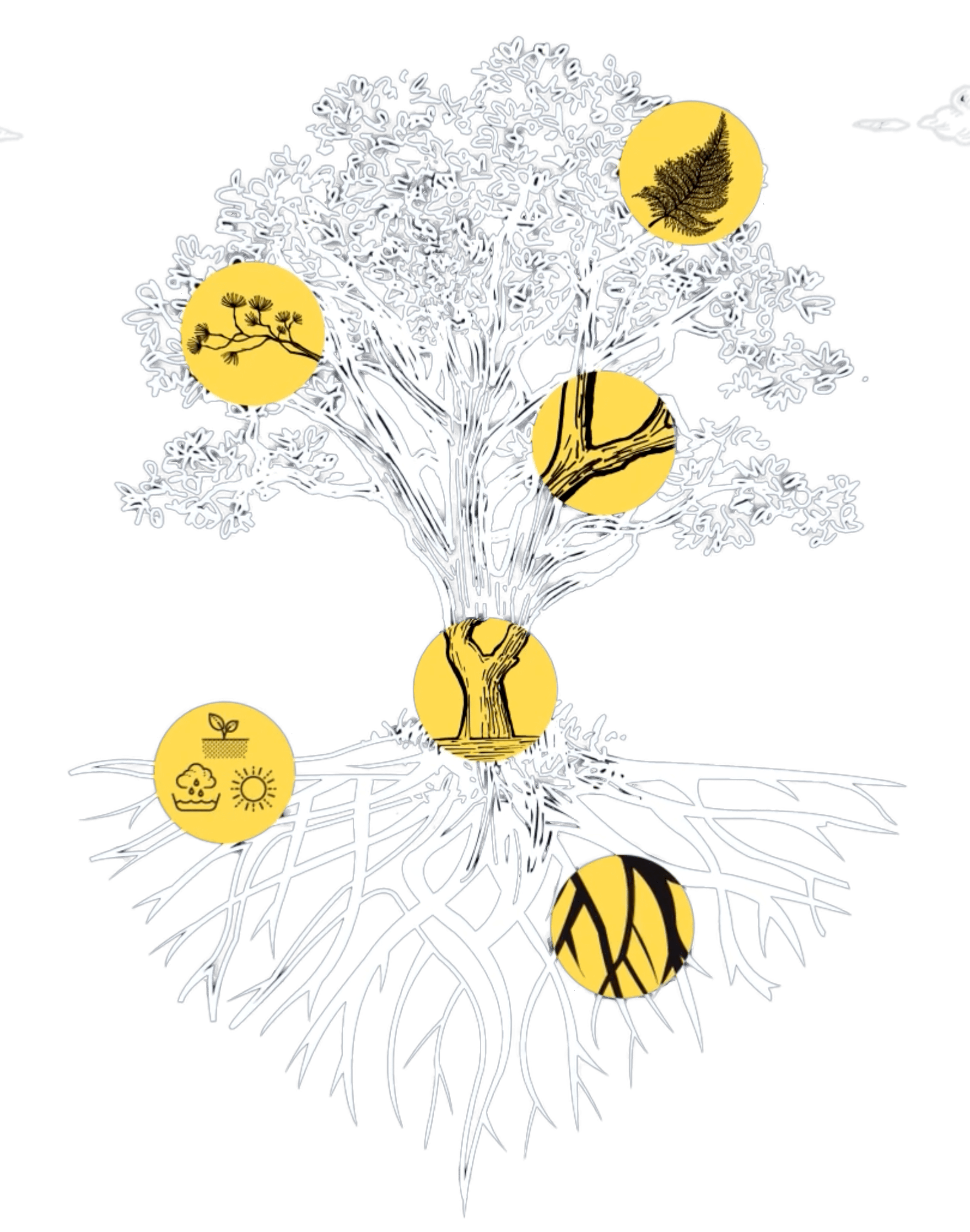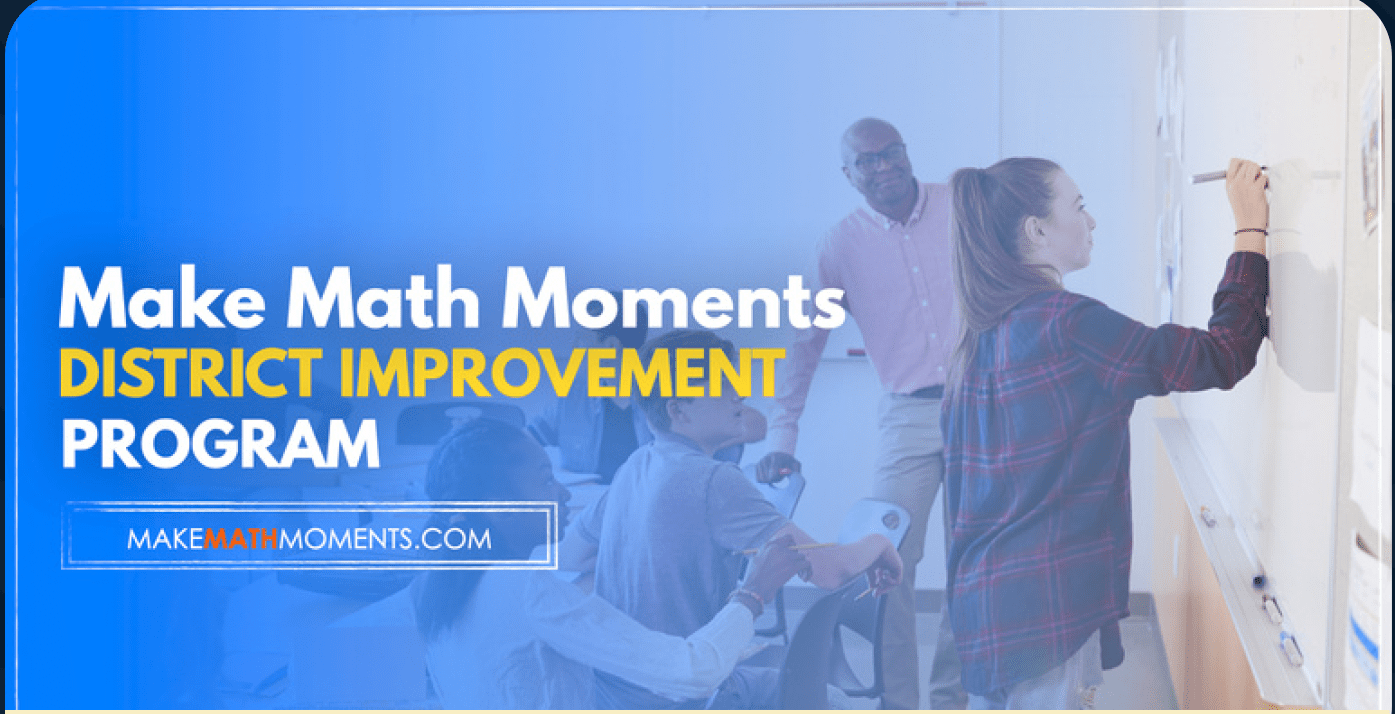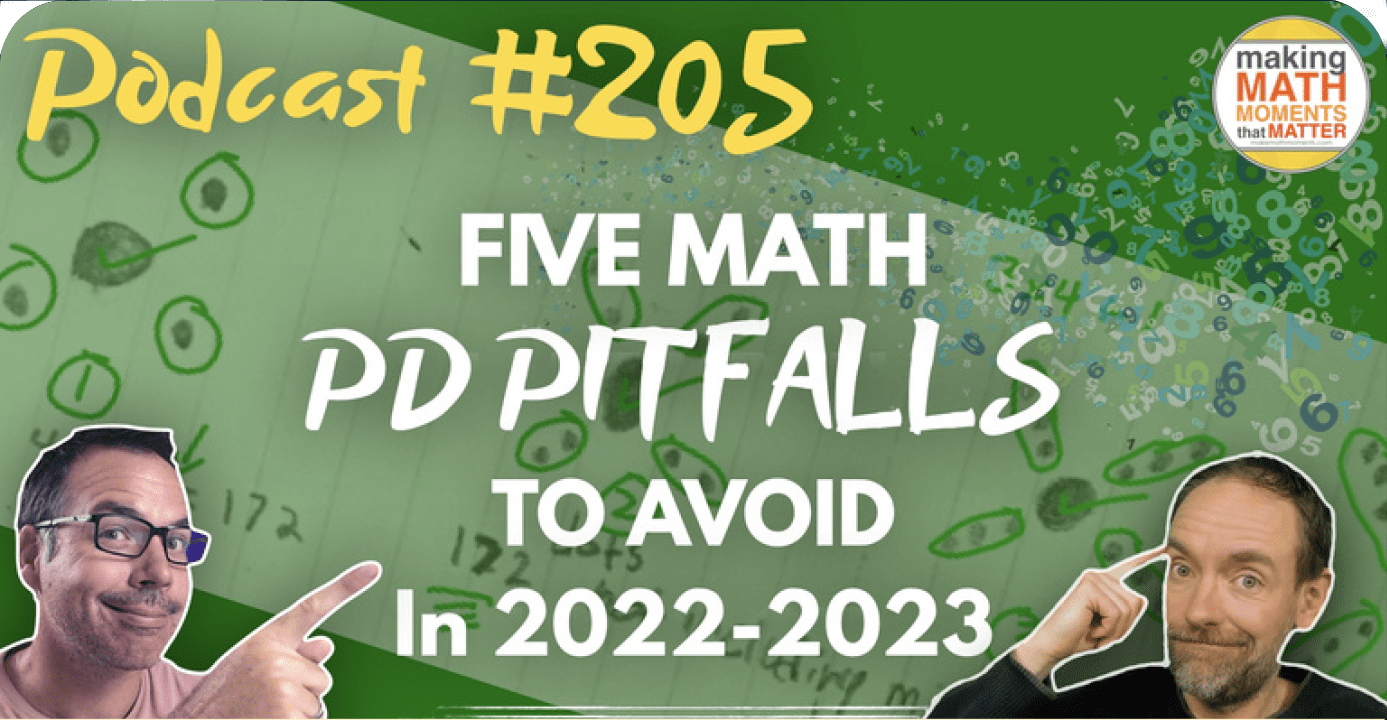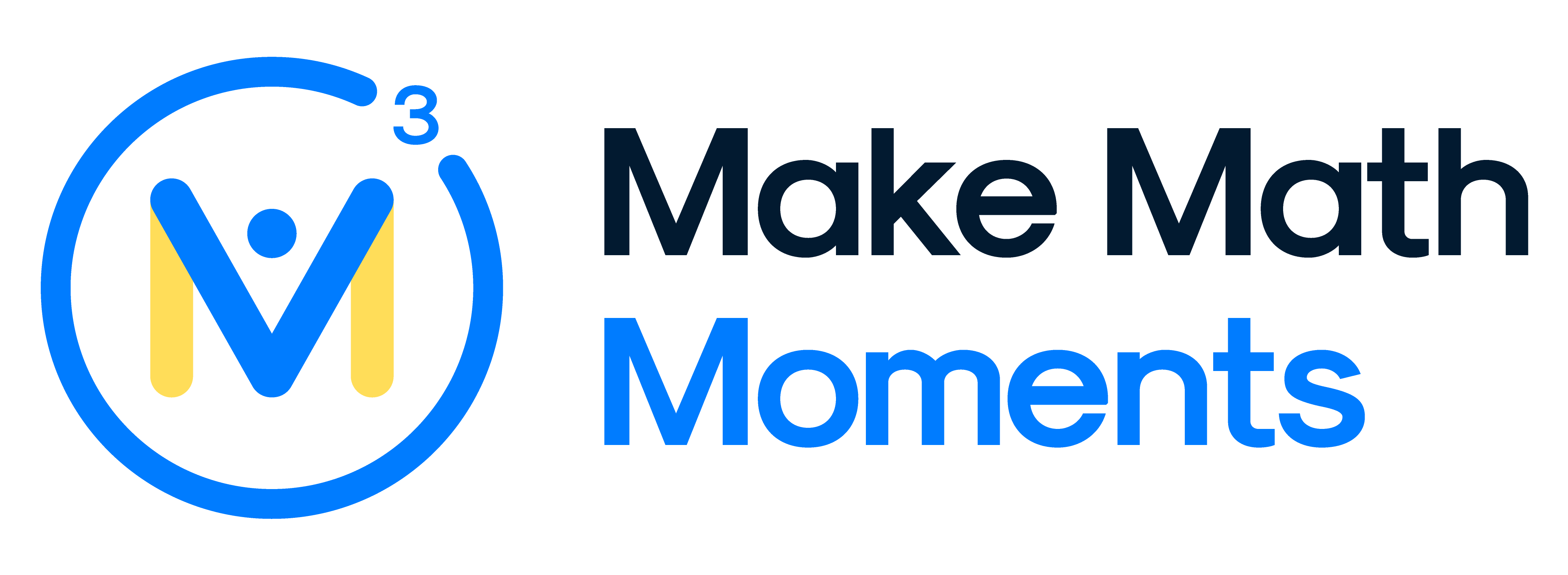YOUR CUSTOMIZED REPORT
Thanks for taking Make Math Moment’s
District Improvement Programs Assessment
At Make Math Moments, we believe that an effective
mathematics program must be cultivated and fostered like a strong, healthy and balanced tree.
This report aims to support, shape and grow the six parts
of the tree that represents your district mathematics
program so it reaches far and wide!
At Make Math Moments we’ve distilled best practices for
strengthening your district or school mathematics
improvement plan into small, easy to manage frameworks
and action items. If you follow the plan laid out in this
report, you’ll avoid many of the common pitfalls and
traps that mathematics leadership teams fall into when
designing their mathematics program.
Can strengthening your district or school mathematics
program be as simple as understanding the six parts of a
growing tree?
Yes, it can! Actually, just being aware of the six parts of
the tree and how they represent the six parts of an
effective mathematics program means you’re already on
your way towards improvement.
Think of this report as your customized plan that will
allow you and your team to optimize your leadership,
mathematics proficiency and content knowledge of your
educators, beliefs and mindset, professional
development structures, educator pedagogical-content
knowledge, and the tools, supports and resources in your
classrooms.
This report will give you a comprehensive list of systems
and processes that have been proven to improve district
mathematics programs.
Make Math Moment’s District Improvement Report will:
- Reveal what is likely missing in your district or school mathematics improvement plan;
- Provide a comprehensive list of systems and processes that have been proven to improve district mathematics programs; and,
- Provide a plan to begin making improvements in your district or school mathematics program
On the next page we will take a look at each of the six disciplines as they relate to your math program.
Based on your assessment
results, we’ll highlight your
greatest area of need.
Your playbook for improving your mathematics program,.
By first highlighting the area of greatest concern and taking steps to address those concerns, you can position your team to then extend your focus to the remaining five areas.
01
Leadership
Trunk
04
Professional
Learning Structure
Limbs
02
Mathematical
Proficiency &
Content Knowledge
Roots
05
Pedagogical-Content
Knowledge
Branches
03
Mindset & Beliefs
Soil, Water, Sunlight
06
Resources, Tools &
Classroom
Environment
Leaves
A PLAN FOR YOUR
MATHEMATICS PROGRAM
Your assessment indicated that your highest area of concern is:
06
Resources, Tools &
Classroom Environment
Leaves

Now that we’ve identified your
greatest area of concern, let’s fix it…
…so your tree will grow strong and wide.


Area to consider
01
Leadership
Trunk
Without strong and capable leaders, nobody knows the vision for the district, why it is important or how to make the vision a reality. Develop your vision, objectives, key results, and share them with your team members so your district or school is in a position to grow your mathematics program to support teaching and learning mathematics in an accessible, equitable and inclusive manner

Area to consider
02
Mathematical Proficiency & Content Knowledge
Roots
The roots of the tree represent mathematics content knowledge and what it means to be mathematically proficient. If your district math program doesn’t consist of educators with deep mathematical content knowledge and promote instruction that develops all five strands of mathematical proficiency, the tree will not get necessary water and nutrients to thrive.

Area to consider
03
Mindset & Beliefs
Soil, Water, Sunlight
Like a tree requires soil, water and sunlight, your district mathematics program requires a productive educator mindset and the belief that all students can achieve at high levels. If this mindset and belief isn’t clear to all students of all cultural backgrounds, socio-economic experiences and learner profiles, your mathematics program struggles to move forward.

Area to consider
04
Professional Learning Structure
Limbs
The limbs of a strong mathematics program are developed through the ongoing professional development structures in place to not only ensure the roots of the tree receive the soil, water and sunlight necessary for healthy growth, but also to provide time, space and support for the rest of the canopy to form.

Area to consider
05
Pedagogical-Content Knowledge
Branches
The roots of the tree represent mathematics content knowledge and what it means to be mathematically proficient. If your district math program doesn’t consist of educators with deep mathematical content knowledge and promote instruction that develops all five strands of mathematical proficiency, the tree will not get necessary water and nutrients to thrive.

Area to consider
06
Resources, Tools & Classroom Environment
Leaves
The food to fuel student sense making in an effective mathematics program will includes having effective resources such as curriculum and content resources, educator and student tools, productive classroom environment elements (i.e.: classroom organization, flexible seating options, etc.) and other resources that welcome more students to the learning.
Take a breath, this list is not intended to create overwhelm.
It will help with creating real, lasting, sustainable change..
You can use this assessment as a step-by-step action plan. Every area you address or work towards fixing with our playbooks and frameworks will take you, your educators, and your students closer to your goals. Aiming to fix the biggest area of need first using the frameworks we provide and then moving to fix the other areas of concern will transform your district mathematics program.
As your district grows and you begin to see changes, feel free to re-take this assessment annually to see how different parts of your program are getting stronger and which parts require more attention.
Need help optimizing your district math program?
The Make Math Moments Team is standing by…
Our Team

Kyle Pearce
Founder

Kyle Pearce
Founder

Kyle Pearce
Founder
We’ll help you to optimize and strengthen your mathematics program without feeling like you’re adding more to your “plate”.
We’ll help you to implement the frameworks that truly make a difference in sustained change in mathematics instruction.
01
Leadership
Trunk
Transform your team of educators and stakeholders by turning
your math program into an initiative with a clear mission.
The number one job of an effective leader is to align
the team around a clear mission. Many math
programs are disjointed and fractured. Districts have
many initiatives that span many disciplines not to
mention if a school inside the district creates their
own initiatives. As a result of an unclear mission or a
mission that does not align with the goals of those
across the district, momentum cannot be generated
and your mathematics goals cannot be attained.
Make Math Moments has a framework that will help
you to clarify your vision by selecting what’s most
important to you and your educators. You’ll learn
how to use our guiding prompts so you can align your
administrators, educators, students, and other key
stakeholders around your vision for mathematics.
Let’s build a vision statement together.
01
Leadership
Trunk
Transform your mathematics program by fine-tuning your improvement plan into an initiative with a clear mission.
01 Leadership
Transform your mathematics program by fine-tuning your
improvement plan into an initiative with a clear mission
Mission statement or initiatives can often be vague or elusive as though they were written by people outside the education space. The problem here is that the mission is confusing or educators do not feel a sense of ownership.
At Make Math Moments we have a process involving
prompts and frameworks that you can use to create a
clear, concise, and actionable vision. A vision that meets
your objectives and has clearly defined, measurable key
results.
Here’s the three step framework:
1. Create a Magic-Wand Wish list.
2. Take an inventory of your current strengths and
areas needing improvement.
3. Craft your vision.
Part 1: Your Magic Wand Wishlist
What do you envision for mathematics teaching and learning in your school or district? While we all want teachers and students to feel capable and confident each day in the mathematics classroom, we must take time to think and reflect on what specifically would contribute to helping us reach that goal.
What do you want your program
to look like 5 year from now?
By brainstorming answers to this prompt you’ll create your wish list. Have your educators also brainstorm their own list. By looking at the intersections of your list and your educators’ list you’ll start to discover where you should narrow your focus.
Part 2: Inventory
Your content goes here. Edit or remove this text inline or in the module Content settings. You can also style every aspect of this content in the module Design settings and even apply custom CSS to this text in the module Advanced settings.
Part 3: Craft Your Vision
Developing an effective mathematics professional learning plan involves thinking about your big (often lofty or bodacious) goals (i.e.: objectives) for educators and students of mathematics in the long run (high-level) and breaking that vision down into smaller, more manageable and measurable goals (i.e.: key results) over the short term (low-level).
Use our workbook to get to work on addressing this need.
01 Leadership
Transform your mathematics program by fine-tuning your
improvement plan into an initiative with a clear mission
You can implement the framework in the following ways:
Title
 Access The Lesson & Workbook
Access The Lesson & Workbook
Watch the video on developing your magic wand wish list and how to create your math vision goals. You may want to include watching this video with your team as part of your district plan. Use the Make Math Moments Leadership workbook as a guide to help craft a vision statement that is clear, concise, and actionable.
Title
 Get Support From Our Team
Get Support From Our Team
You can hop on a call with the Make Math Moments District Improvement Program Team to receive guidance, support, coaching and trainings that will help you fine-tune your mathematics program into an initiative with a clear mission that educators will get behind.
02
Mathematical Proficiency and
Content Knowledge
Roots
How well positioned are your educators to plan and deliver lessons that emphasize the 5 strands of mathematical proficiency?
Help your educators strengthen their own mathematical proficiency by building fluency and flexibility with the big ideas,
strategies and models of mathematics so we can Make Math Moments in our classrooms everyday.
If we strive to develop a truly sustainable mathematics program that promotes the strengthening of student mathematical understanding, we must ensure our educators are positioned to do so. This begins with providing teachers with the opportunity to understand what it means to be mathematically proficient and provide opportunities to develop their own mathematics content knowledge.
Providing educators with the time, tools and support to
grow their own mathematical roots that stretch deep and
wide through regular opportunities to solve mathematics
problems, co-plan lessons and moderate student work
builds the confidence, understanding and excitement to
support all students in their ever increasingly diverse
classrooms.
02
Mathematical Proficiency & Content Knowledge
Roots
Help your educators strengthen their own mathematical
proficiency by building fluency and flexibility with the big ideas,
strategies and models of mathematics so you can Make Math
Moments in your classrooms everyday.
02 Mathematical Proficiency & Content Knowledge
Help your educators in developing
their mathematical proficiency
Very few mathematics leadership teams recognize that an effective mathematics program relies on the educator of mathematics having a high level of mathematics content knowledge and strength across all five strands of mathematical proficiency. Regardless of the curriculum resource provided to educators of mathematics, if they themselves do not have a high level of mathematical proficiency, they will not be able to deliver a program that develops the mathematical proficiency of their students.
The only thing harder than developing an effective mathematics program is helping educators to understand what it means to be mathematically proficient and helping them get there themselves. Many mathematics leadership teams are sitting on textbooks, manipulatives, and many other resources that have been purchased with an intent to improve student achievement in mathematics, but their educators don’t know how to use
them effectively.
Make Math Moments helps your mathematics leadership team understand what it means to be mathematically proficient through our online platform of professional learning resources including live and self-paced courses, over 60 problem based units of study with full facilitator guides and leadership team planning calls to help you and your team gain a clear vision of mathematical proficiency.
Through the Make Math Moments District Improvement
Program, we work with your mathematics leadership
team to know, understand and share the five strands of
mathematical proficiency with your educators:
- Conceptual Understanding: Ability to understand
mathematical concepts, operations, and relationships - Procedural Fluency: Understanding and using a
variety of mathematical procedures - Adaptive Reasoning: Capacity for logical thought,
reflection, explanation, and justification - Strategic Competence: Ability to formulate, represent
& solve mathematical problems using an effective
strategy - Productive Disposition: Inclination to see
mathematics as useful and valuable
Is Your Math Leadership Team Well-Positioned to
Develop an Understanding of the 5 Strands of
Mathematical Proficiency?
02 Mathematical Proficiency & Content Knowledge
Help your educators in developing
their mathematical proficiency
To support the development of educator mathematical proficiency and content knowledge, you can:
Title
 Get Support From Our Team
Get Support From Our Team
You can hop on a call with the Make Math Moments District Improvement Program Team to receive guidance, support, coaching and trainings that will help you fine-tune your mathematics program into an initiative with a clear mission that educators will get behind.
03
Mindset & Beliefs
Soil, Water, Sunlight
Do all your teachers believe that ALL students are capable of
achieving at high levels in mathematics?
Shifting educator mindset and beliefs is a necessary
component of an effective mathematics program.
How can we inspire change when the thought of change is interpreted as more work and little impact. Teachers are handed new initiatives to implement each year, often times without the necessary professional learning required to understand why they are helpful and how they can be implemented effectively. It shouldn’t be surprising that new initiatives receive pushback from educators
The Make Math Moments District Improvement Program works with your mathematics leadership team to co-construct an action plan driven by the key motivators that spark sustainable change in teacher mindset and beliefs while supporting your team with resources to make it happen.
03
Mindsets & Beliefs
Water, Soil, Sunlight
Shift educator mindsets and beliefs from
deficit thinking towards asset thinking.
03 Mindsets & Beliefs
Shift educator mindsets and beliefs from deficit thinking towards asset thinking.
One of the most challenging areas that leadership teams are responsible for creating change is in the area of educator mindset and beliefs. Only once we are able to begin shifting these well-established mindsets and beliefs can true growth towards effective instructional practice take place.
The Make Math Moments team implements the 3 stage process shared by Chip and Dan Heath in their book Switch: How To Change When Change Is Hard. By applying this process with your mathematics leadership team and integrating these ideas into the professional learning opportunities you provideo for your educators, you will be able to positively influence your most reluctant educators to begin shifting from traditional lecturers to Math Moment Makers
Our minds are controlled by two different systems of the brain: The Emotional Side and The Rational Side. When we make decisions (big or small) we are in a constant battle between these two systems. Your emotional side will want to do what is quick and easy, while the rational side of the brain takes more time and effort to determine what makes the most sense based on logic. As you can imagine, the quick-thinking emotional side wins the vast majority of the time and along with it, a choice that is not always the most logical.
To help you better understand how the human brain functions, the authors describe the systems working together
like a rider trying to direct an elephant down a path.
The rider represents the slow thinking, rational system of the brain. Despite being the logical system that can often decide on the best way forward, the much smaller rider requires more time and effort to think leaving the large, emotionally charged and fast thinking elephant to make most of the decisions. Unless the rider is able to successfully direct the elephant to follow the most reasonable path, it will go where it wants, when it wants.
To successfully shift educator mindsets and beliefs, you must:
1. Direct the Rider 2. Motivate the Elephant 3. Clear the Path
03 Mindsets & Beliefs
Shift educator mindsets and beliefs from deficit thinking towards asset thinking.
Follow these guidelines to begin shifting the mindsets and beliefs of your mathematics educators:
1. Direct the Rider
Find the Bright Spots
Find the bright-spots in your mathematics program by seeking out educators whose mindsets and beliefs align with the goals of your math vision. Help them build on successes and amplify their voices to organically direct other riders.
Script the Moves
Make your Math Vision clear to your educators and top of mind.
Routinely referencing the vision and showcasing what it looks like in practice day-to-day will help your rider stay on the right path.
2. Motivate the Elephant
Find the Feeling
Excite the elephant by making the progress and impact they are having on student achievement visible. Providing educators with positive emotional experiences to learn, implement and reflect on the work they are doing (i.e.: implementing problem based lessons) can motivate further change.
Shrink The Change
Start small and focus on gaining quick and easy wins. Ensure educators recognize that it is realistic to make positive change without adding an over-whelmingly large amount of work and that the payoff is positive and rewarding.
3. Shape the Path
Tweak The Environment
Plan for the ways in which you can
clear the path for the elephant.
What barriers make it difficult for
the rider to guide the elephant
down your desired pathway? Nudge educators down the path by making desirable actions easy to do and undesirable actions difficult.
Build Habits
Sustainable change is fuelled by habit. How will your mathematics leadership team help your educators to build habits that make the mathematics vision an automatic part of their daily/weekly routine?
03 Mindsets & Beliefs
Shift educator mindsets and beliefs from deficit thinking towards asset thinking.
To shift educator mindsets & beliefs, you can:
Title
 Listen The Podcast Episode
Listen The Podcast Episode
Listen to this Math Mentoring Moment episode of our podcast as we coach a mathematics specialist through a challenge related to an ineffective mathematics intervention model. You’ll hear an example of how you can share your ideas for change when it might seem challenging and how to make small changes through nudging without overwhelming.
Title
 Get Support From Our Team
Get Support From Our Team
You can schedule on a call with the Make Math Moments District Improvement Program Team to receive guidance, support, coaching and trainings that will help you design an action plan to drive key motivations that spark sustainable change in pedagogical practice and teacher moves.
04
Professional Learning Structure
Limbs
How often are educators of mathematics engaging in
mathematics professional learning?
How much mathematics professional learning is programdirected vs. self-directed?
The mathematics professional learning structures (or lack thereof) we put into place to support our educators as they grow their own “tree” can help to develop a healthy, strong and balanced tree or hinder and suppress that tree from growing at all.
If your professional learning team isn’t inviting your teachers of mathematics into a meaningful story, you will not be able to support the work over the long term and create the momentum needed for real change.
04
Professional Learning Structure
Roots
Create a sustainable, supportive, and
actionable professional development
structure that creates positive change.
04 Professional Learning Structure
Create a sustainable, supportive, and actionable professional
development structure that creates positive change.
To create sustainable, supportive and actionable development structures that truly creates change you’ll first need to avoid these common pitfalls and then learn what to do instead.
Avoid These Common Professional Learning Pitfalls
Avoid
Do As I Say, Not As I Do PD Sessions
Setting Unrealistic or
Unattainable Goals
Stop Force Feeding and Start “Bread Crumbing” the Learning
Limit “One-Off” Professional Learning Sessions
Overcome The Math
PD Paradox
What to do instead
Plan and deliver professional learning using the same effective teaching practices you want your educators to use when facilitating math lessons. Don’t tell them what is wrong and how to fix it; craft experiences for them to emerge this learning
Choose one of your vision goals (key results),
share, and support your educators around that
goal before introducing more.
Use the “Bread Crumb Strategy” for mathematics professional development.
Stop wasting time and money on a model that doesn’t create change. Use a model that promotes coaching, lesson-study, and one-on-one support.
Find ways to align the professional learning goals of your mathematics educators with the goals of your mathematics vision.
Take Action
04 Professional Learning Structure
Create a sustainable, supportive, and actionable professional
development structure that creates positive change.
To create sustainable, robust, and flexible
professional learning structures, you can:
Title
 Watch The Video Series
Watch The Video Series
In this two part series the Math Moments team discuss & break down math PD pitfalls we should all avoid so that we can support, encourage, and build engaged educators who want to spark curiosity and fuel sense making in students.
Title
 Get Support From Our Team
Get Support From Our Team
You can hop on a call with the Make Math Moments District Improvement Program Team to receive guidance, support, coaching and trainings that will help you fine-tune your mathematics program into an initiative with a clear mission that educators will get behind.
05
Pedagogical-Content Knowledge
Branches
How many of the 8 Effective Mathematics Teaching
Practices would you say are being incorporated with a high
degree of effectiveness in mathematics classrooms across
your school/district?
The branches of your tree represent the development of educator mathematics pedagogical-content knowledge including effective teaching and equity based teaching practices. If you are spending valuable professional learning time on too many things that don’t make an impact, the canopy of your tree will get heavy and begin to sag, hindering growth.
Without a sound system in place to support and develop our educators high yield teaching moves we cannot generate consistent student growth across your mathematics program. Focusing your time, resources, and support around The NCTM 8 Effective Teaching Practices will help you strengthen your program.
05
Pedagogical-Content Knowledge
Branches
Develop and support your educators to leverage
the 8 Effective Teaching Practices and 5 Equity Based Teaching Practices.
05 Pedagogical-Content Knowledge
Develop and support your educators to leverage the 8 Effective
Teaching Practices and 5 Equity-Based Teaching Practices.
Use these free trainings to help strengthen the
8 Effective Teaching Practices with your educators
Effective Practice
Link to Training
Establish mathematics
goals to focus learning
ACCESS TRAINING:
Stop using These Two
Formative Assessment
Techniques
Implement tasks that
promote reasoning and problem solving
ACCESS TRAINING:
How To Transform Your
Lessons & Resources Into
Curious Tasks
Use and connect
mathematical
representations
ACCESS TRAINING:
Stop using These Two
How To Promote Mathematical Models
with Students & Teachers
Facilitate meaningful mathematical discourse
ACCESS TRAINING:
Pose purposeful
questions
ACCESS TRAINING:
Build procedural fluency from conce-ptual understanding
ACCESS TRAINING:
Support productive
struggle in learning
mathematics
ACCESS TRAINING:
Elicit and use evidence
of student thinking
ACCESS TRAINING:
05 Pedagogical-Content Knowledge
Develop and support your educators to leverage the 8 Effective
Teaching Practices and 5 Equity-Based Teaching Practices.
Next steps to help your educators with implementing the 8 Effective Teaching Practices and the 5 Equity-Based Teaching Practices:
Title
 Read These Books & Take Action
Read These Books & Take Action
These books are necessary reads for all stakeholders in mathematics education, but particularly for administrators including directors, superintendents, principals, and curriculum coordinators, consultants, chairs and department heads. By taking the actions outlined in these books, you’ll see measurable steps towards your mathematics vision.
Title
 Get Support From Our Team
Get Support From Our Team
You can schedule on a call with the Make Math Moments District Improvement Program Team to receive guidance, support, coaching, trainings, and classroom resources so you can support your educators to leverage the 8 Effective Teaching
Practices and 5 Equity-Based Teaching Practices.
06
Resources, Tools
& Classroom Environment
Leaves
Are you and your educators of mathematics using a
framework to structure math lessons designed with research
based practices in mind? Your math program should utilize
resources designed to spark curiosity and fuel sense making
in students.
The food to fuel student sense making in an effective mathematics program includes having effective resources such as curriculum and content resources, educator and student tools, productive classroom environment elements (i.e.: classroom organization, flexible seating options, etc.) and other resources that welcome more students to the learning.
Strengthening your district math program will require
access to curriculum resources that:
- assist in the development of educator mathematics
content knowledge and pedagogy as they
implement the resource with students during each
lesson; - creates space for educators to leverage a repertoire
of various pedagogical moves including problem
solving, direct instruction and purposeful practice; - assists your educators of mathematics to
incorporate problem solving and productive
struggle opportunities in their lessons; and, - provide content that allows and promotes
educators to differentiate to meet a wide range of
student readiness.
06
Resources, Tools
& Classroom Environment
Leaves
Utilize resources that designed to spark
curiosity and fuel sense making in students.
06 Resources, Tools & Classroom Environment
Utilize resources that designed to spark curiosity and fuel sense making in students.
Ensure the curriculum resources you provide or are seeking to
implement meet the following criteria:
- assists in the development of educator mathematics content knowledge and pedagogy as they implement the resource with students during each lesson;;
- creates space for educators to leverage a repertoire of various
pedagogical moves
including problem
solving, direct
instruction and
purposeful practice;
- assists your educators of mathematics to
incorporate problem
solving and productive
struggle opportunities in lessons regularly; and,
- aprovides content that
allows and promotes
educators to
differentiate to meet a
wide range of student
readiness, cultural
backgrounds and
diverse experiences.
You’ll need to take these actions:

Ensure the curriculum resource follows the Make Math Moments 3-Part Framework.

Learn how to help your staff transform the existing resources into curious lessons.

Learn how to effectively deliver problem based lesson professional development.
06 Resources, Tools & Classroom Environment
Utilize resources that designed to spark curiosity and fuel sense making in students.
To utilize resources that spark curiosity, fuel sense making and
offer accessibility to all students across your district, you can:
Title
 Access Our Classroom Units
Access Our Classroom Units
Each one of our ready-to-go classroom units has been created to not only spark curiosity and fuel student sense making, but they have been carefully created to blend with all 5 other components of an effective mathematics program. Each lesson is equipped with teacher supports so that your educators build confidence as they teach.
Title
 Take Our Flagship Course
Take Our Flagship Course
Take our self-paced flagship course where we teach you how to use our 3-part framework for building easy to plan and fun to deliver lessons that kids will not only love, but also learn from. We also show you how to transform the lessons from your current resource using the framework.
Title
 Get Support From Our Team
Get Support From Our Team
You can schedule on a call with the Make Math Moments District Improvement Program Team to receive guidance, support, coaching, trainings, and classroom resources so you can help more educators implement lessons that spark curiosity and fuel sense making.
If you’ve been searching for a plan of action to create sustainable
and actionable change in your mathematics program, then use
this report as your blueprint to begin making change.
To transform your mathematics program, begin by doing the following:
1. Decide whether you are the one to carry out this actionable change or will you need a team to help? Assemble your team and carry out this plan.
2. Start with addressing and strengthening the weakest parts of your program using the strategies we presented here and then move to strengthen the other components or consider
beginning from the start and strengthen your program in the order we’ve presented here.
3. Understand that true change takes time. It may take years to achieve any big audacious goals you are setting now. It is important to focus on achieving those specific key results outlined in this report.
4. When you have taken time to address all 6 areas of your mathematics program, cycle back through each area and continue strengthening your program.
Need more help in making the sustainable change in
your district’s or school’s math program?
Here is how Make Math Moments can help you:
Join the Make Math Moments District Improvement Program. Partnering with us can help fast-track the process outlined above while you receive one-on-one (or small team) coaching, support, and resources to create sustainable change in your district. Book a time to chat with our team to see if our program is the right fit
My District Math Improvement Report


